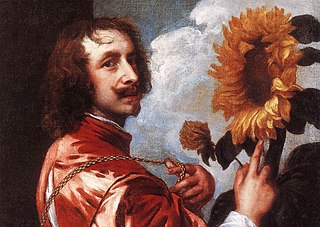
Born: 22 March 1599, Antwerp
Died: 9 December 1641 (aged 42)
Period: Baroque
The Life of Anthony van Dyck
Anthony van Dyck, born on March 22, 1599, in Antwerp, was a Flemish Baroque artist who became one of the most prominent court painters in England. He is best known for his portraits of Charles I of England and the nobility, which are characterized by their elegance, refinement, and technical mastery.
Van Dyck was born into a wealthy family of silk merchants and showed an early talent for painting. He became a pupil of Hendrick van Balen at the age of ten and later studied under Peter Paul Rubens, who was the leading artist in Antwerp at the time. Van Dyck’s association with Rubens had a profound influence on his work, and he quickly developed a sophisticated style that combined a keen observation of detail with a grandeur of composition.
By his early twenties, Van Dyck had established himself as a leading portraitist in his own right and began traveling throughout Europe. He spent time in Italy, where he was influenced by the work of Titian, and his style became noted for its use of color and light, as well as the psychological depth of his portraits. While in Italy, Van Dyck painted portraits of several notable figures, including members of the aristocracy and the Catholic Church.
In 1632, Van Dyck was invited to England by Charles I, who appointed him Principal Painter in Ordinary. His time in England marked the peak of his career, and he created many of his most famous works during this period. Van Dyck’s portraits of the English monarchy and nobility were instrumental in shaping the image of the Stuart court, and his elegant, flattering style had a lasting impact on English portrait painting.
Van Dyck’s influence extended beyond his immediate circle; his portraits set a new standard for elegance and grace in European art. He was also an important innovator in printmaking, producing a series of engravings that were widely circulated and highly influential.
Despite his success, Van Dyck’s health began to decline in the early 1640s, and he died on December 9, 1641, in London. He left behind a vast body of work that had a profound influence on the development of portrait painting in Europe. His legacy is evident in the works of subsequent English portrait painters, who drew inspiration from his style and approach to portraiture. Van Dyck remains celebrated as one of the greatest portraitists of all time, and his works continue to be admired for their beauty, sophistication, and insight into the human character.
Anthony van Dyck’s Notable Works
Anthony van Dyck is celebrated for his portraits that combine elegance, sophistication, and a profound sense of character. Here are ten of his most famous works, which have cemented his reputation as a master portraitist:
- Charles I in Three Positions (1635-1636) – A triple portrait of King Charles I, showcasing Van Dyck’s skill in capturing the dignity and humanity of his subjects. This painting was sent to Rome to be used by the sculptor Gian Lorenzo Bernini to create a bust of Charles I.
- Equestrian Portrait of Charles I (1637-1638) – This grand portrayal of Charles I on horseback highlights Van Dyck’s ability to convey royal majesty and power, set against a dramatic landscape.
- Self-Portrait with a Sunflower (circa 1632-1633) – This work is noted for its innovative composition and the symbolic use of a sunflower, representing loyalty to the king, with the sunflower turning towards the sun as the subject does towards the monarch.
- Portrait of Henrietta Maria with Sir Jeffrey Hudson (1633) – A portrait of the queen consort of England with her dwarf courtier, demonstrating Van Dyck’s finesse in rendering textures and his sensitive portrayal of his subjects.
- The Children of Charles I (1637) – This touching group portrait of the king’s children is admired for its intimate portrayal and the detailed rendering of the children’s expressions and attire.
- Lord John Stuart and his Brother, Lord Bernard Stuart (circa 1638) – One of Van Dyck’s most celebrated double portraits, showcasing the lavish attire and aristocratic bearing of the Stuart brothers.
- Samson and Delilah (circa 1630) – While Van Dyck is primarily known for his portraiture, this painting is a fine example of his skill in historical and biblical subjects, offering a dramatic and emotive interpretation of the biblical story.
- Portrait of Olivia Boteler Porter (circa 1638) – A striking portrait of the lady-in-waiting to Henrietta Maria, showcasing Van Dyck’s ability to capture the elegance and grace of his female subjects.
- Cupid and Psyche (1639-1640) – A mythological painting that stands out for its romantic portrayal of the lovers, highlighting Van Dyck’s mastery in depicting the nude form and his use of light to create atmosphere.
- The Lamentation over the Dead Christ (circa 1635) – This religious painting is noted for its emotional depth and the realistic portrayal of grief, demonstrating Van Dyck’s versatility and his ability to convey complex human emotions.
Van Dyck’s oeuvre is a testament to his unparalleled skill in portraiture, his ability to imbue his subjects with dignity and depth, and his influence on the development of portrait painting in England and beyond.